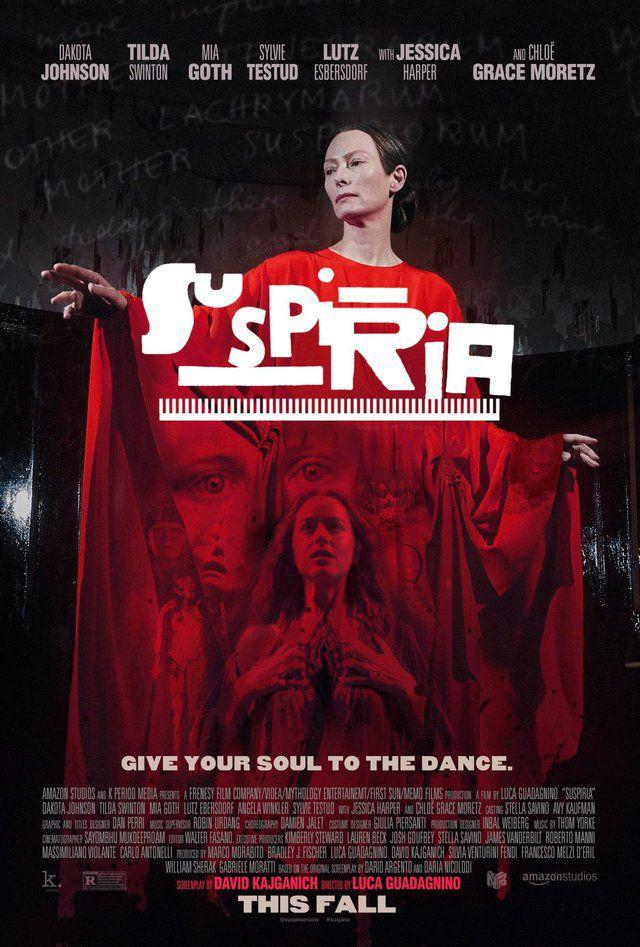Directed by Luca Guadagnino, “Suspiria” is the English-laguage remake of the famous 1977 giallo film by the same name directed by Dario Argento. However, unlike most modern remakes, Guadagnino simply draws inspiration from the original and creates his own unique film. With the directoral experience of Guadagnino and the powerhouse performances of Tilda Swinton, Guadagnino’s “Suspiria” surpasses the original.
In 1977, Argento’s “Suspiria” drew American attention to the giallo genre. Argento beautifully crafts a colorful nightmare as an American student discovers that the German ballet academy she is studying at hides sinister secrets. Both the original and modern versions follow Susie’s descent into the depths of the secrets of the academy, but Guadagnino’s version alters her fate.
Almost instantly, Guadagnino proclaims his deviation from the original with the use of title cards to mark the chapters of the film. Title cards are rarely seen in modern film, but Danish filmmaker Lars Von Trier uses them to establish a sober tone for certain scenes, which has shaped the modern usage of title cards. Guadagnino uses this subtle touch to immediately establish that his “Suspiria” will not match the dream-like atmosphere of the original.
Not only is “Suspiria” a deviation from its original source material, it is also a deviation from the rest of Guadagnino’s works. Guadagnino has certainly established himself as a master of subtlety and sensuality. “Call Me By Your Name,” “A Bigger Splash” and “I Am Love” are among the most tranquil films from the past 10 years. However, “Suspiria” is void of Guadagnino’s signature subtlety and constantly bombards the audience with sensory overload.
Dakota Johnson is fantastic in her role as Susie Bannion, and in many instances she holds the weight of the film on her shoulders. However, her co-star Tilda Swinton outshines Johnson when they share the screen.
Swinton actually has multiple roles in the film, including the choreographer of the ballet company and the male psychotherapist who begins to investigate the academy after hearing ominous rumors. Swinton has the ambience of the supernatural as she is able to draw the natural talent out of Susie and shape her into the lead of the company, but she also conveys the grounded human aspects of a worried therapist caring for his patients.
Guadagnino’s version is almost double the length of the original, and fans of the original may become restless with the dreariness of the plot at times. As the film progresses, Guadagnino’s style grinds down the audience, constantly teasing them with giallo-style dream sequences that push the audience to the point of exhaustion. However, the first five acts of the film are subtly building toward a finale that will shock and probably upset fans of the original film.
Despite Guadagnino’s deviation from the plot of the original, he certainly makes his love for the original film and his love for the giallo genre undoubtedly clear. Guadagnino brilliantly brings to life a genre that most thought to be stuck in the past, and his balance of subversion and love for the original “Suspiria” produces a wonderful result.
Rating: 4/5
Cole Fowler is an English sophomore and Life & Arts writer for The Battalion.
‘Suspiria’: The resurrection of giallo
November 11, 2018
Photo by Creative Commons
The 2018 version of “Suspiria” may be modeled after the 1977 version, but according to Cole Fowler it is its own unique film.
0
Donate to The Battalion
$1745
$5000
Contributed
Our Goal
Your donation will support the student journalists of Texas A&M University - College Station. Your contribution will allow us to purchase equipment and cover our annual website hosting costs, in addition to paying freelance staffers for their work, travel costs for coverage and more!










